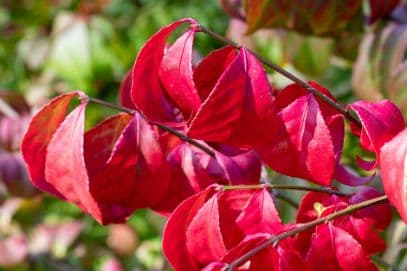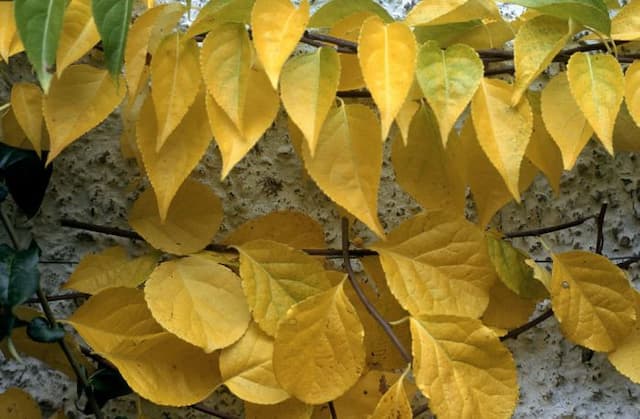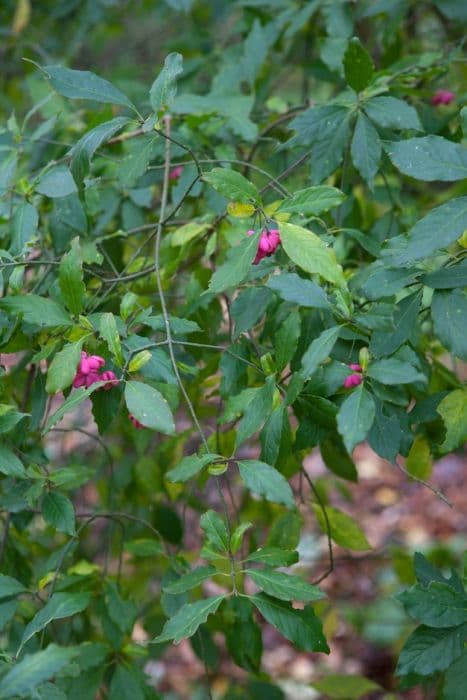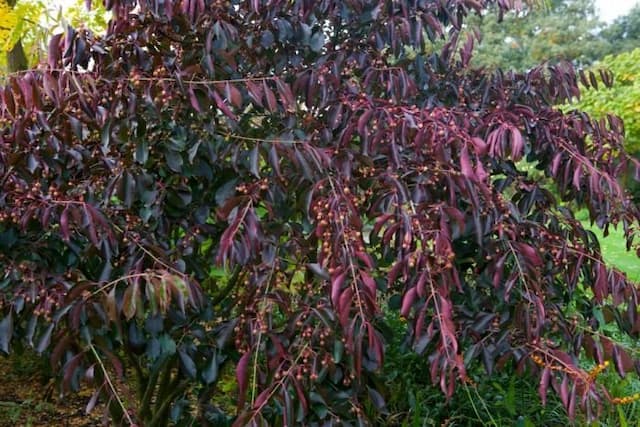Burning Bush Euonymus alatus 'Fire Ball'

ABOUT
The plant known as 'Fire Ball' Burning Bush has a striking appearance, characterized by its vibrant and dense foliage. Its leaves have an oval shape with finely serrated edges and are known for their bright green color during the spring and summer months. As autumn approaches, the foliage undergoes a dramatic transformation into a fiery red hue, from which the plant's common name is derived. The branches of the 'Fire Ball' Burning Bush are notable for their distinctive, corky ridges that create an interesting texture and add to the plant's ornamental appeal. These wing-like projections on the stems add to the visual interest of the plant throughout the year, even after the leaves have fallen. The flowers of this plant are relatively inconspicuous, commonly being a light green or yellow color. They do not generally stand out against the foliage, and as such, they are not the main focus for this plant's aesthetic value. Following the flowering period, the 'Fire Ball' Burning Bush produces small fruits that can attract birds and wildlife. These fruits are a subtle feature that adds an additional aspect of interest to this showy plant. Beyond these characteristics, the 'Fire Ball' Burning Bush is appreciated for its overall dense and rounded habit, which contributes to its prominence as a decorative plant in many gardens. Its striking seasonal color changes and textured stems make it a popular choice for creating visual contrast and interest in landscaping designs.
About this plant
 Names
NamesFamily
Celastraceae.
Synonyms
Burning Bush, Winged Euonymus, Winged Spindle Tree, Winged Burning Bush.
Common names
Euonymus alatus 'Fire Ball'.
 Toxicity
ToxicityTo humans
Burning bush, the common name for Euonymus alatus 'Fire Ball', is known to be toxic to humans if ingested. Consuming parts of this plant can cause symptoms such as nausea, vomiting, diarrhea, weakness, and in severe cases, can lead to more serious symptoms like changes in heart rate or rhythm. The most toxic parts are the seeds and any ingestion should be taken seriously, seeking immediate medical attention.
To pets
In pets, the burning bush is also toxic. If ingested by animals such as dogs and cats, it can produce symptoms similar to those in humans, including vomiting, diarrhea, and abdominal pain. Ingestion of the seeds can be particularly harmful and may lead to more severe symptoms. Immediate veterinary care is recommended if a pet has consumed any part of this plant.
 Characteristics
CharacteristicsLife cycle
Perennials
Foliage type
Deciduous
Color of leaves
Green
Height
5 feet (1.52 meters)
Spread
5 feet (1.52 meters)
Plant type
Shrub
Hardiness zones
4
Native area
Asia
Benefits
 General Benefits
General Benefits- Striking Fall Color: Provides vibrant red foliage in the autumn, making it a standout in the landscape.
- Low Maintenance: Requires minimal pruning and is relatively easy to care for once established.
- Drought Tolerant: Can survive in dry conditions after it has been established, reducing the need for frequent watering.
- Compact Size: The 'Fire Ball' cultivar is more compact than the species, making it suitable for smaller gardens or spaces.
- Wildlife Attraction: Can attract birds with its fruit, providing food for wildlife.
- Winter Interest: Its winged stems provide visual interest in the winter landscape.
- Adaptability: Adapts well to a variety of soil types and conditions.
 Medical Properties
Medical PropertiesThis plant is not used for medical purposes.
 Air-purifying Qualities
Air-purifying QualitiesThis plant is not specifically known for air purifying qualities.
 Other Uses
Other Uses- Photography Subject: The vibrant red foliage of Burning Bush makes it an excellent subject for nature and garden photographers, especially in autumn when the leaves turn bright red.
- Hedge Maze Material: Because of its dense growing habit, Burning Bush can be used to create living hedge mazes in gardens and parks.
- Privacy Screens: Burning Bush hedges can be planted to create natural privacy barriers between properties or to conceal unsightly areas.
- Seasonal Decorations: Branches of the Burning Bush, with their fiery fall leaves, can be used in seasonal floral arrangements or as part of autumn decoration themes.
- Wildlife Shelter: The thick foliage provides shelter for small animals and birds within a garden setting, offering a habitat for local wildlife.
- Craft Projects: Dried branches of the Burning Bush can be used in craft projects, like wreath making or basket weaving, particularly appreciated for their unique winged bark.
- Theme Gardens: Can be included in "four seasons" theme gardens due to its interesting year-round appearance, including a pronounced change in fall color.
- Artistic Inspiration: Artists may use the intense fall coloration as inspiration for paintings, textiles, and other forms of art.
- Learning Tool: The distinctive winged bark and four-season interest make Burning Bush a good specimen for educational purposes in botany and horticulture classes.
- Topiary: With regular pruning, Burning Bush can be shaped into various forms, making it suitable for topiary gardens.
Interesting Facts
 Feng Shui
Feng ShuiThe plant Euonymus alatus, commonly known as Burning Bush, is not typically referenced in Feng Shui practice.
 Zodiac Sign Compitability
Zodiac Sign CompitabilityThe Burning Bush is not used in astrology practice.
 Plant Symbolism
Plant Symbolism- Transformation: The Euonymus alatus 'Fire Ball', commonly known as Burning Bush, undergoes a stunning transformation from green to fiery red in the fall, symbolizing change and adaptability.
- Attention-grabbing: With its bright red foliage, the Burning Bush commands attention, representing the importance of being noticed and not fading into the background.
- Guidance: In the biblical context, the burning bush is a symbol of guidance and divine presence, which can be extended to the plant as a symbol for finding one's way or spiritual enlightenment.
- Resistance: The Burning Bush is known for its hardiness and ability to thrive in various conditions, symbolizing resistance and persistence through challenges.
 Water
WaterThe Burning Bush requires water regularly, especially during the first growing season as it establishes its root system. After establishment, it's more drought-tolerant. Generally, watering deeply once a week with about 1-2 gallons should suffice, but this might need to increase during periods of extreme heat or drought to maintain moist but not saturated soil. Over-watering can cause root rot, so ensure the plant is in well-draining soil and excess water can escape.
 Light
LightThe Burning Bush prefers full sun to partial shade. It thrives in a location that receives at least 4-6 hours of direct sunlight daily, which will encourage the most vibrant fall color. However, it can tolerate some shade, particularly in the hotter afternoons, but its foliage might not be as bright and dense.
 Temperature
TemperatureThe Burning Bush is winter-hardy and can withstand temperatures as low as -30 degrees Fahrenheit. Its ideal growing temperatures range between 60 and 80 degrees Fahrenheit. It can survive in heat zones up to about 90 degrees Fahrenheit but might require additional watering during periods of intense heat to prevent stress.
 Pruning
PruningPrune the Burning Bush to maintain its shape and remove any dead or diseased branches. Pruning is best done in late winter or early spring before new growth starts. It can be pruned annually if desired, but heavy pruning should only be done every few years to avoid stressing the plant. Pruning can stimulate new growth and enhance the plant's natural form.
 Cleaning
CleaningAs needed
 Soil
SoilBurning Bush prefers well-drained loamy soil with a pH of 6.0 to 8.0. A mix of garden soil, compost, and peat moss will create an ideal environment for root growth and health. The addition of perlite or sand can improve drainage.
 Repotting
RepottingBurning Bush, a shrub, generally does not require repotting. Plant it in the ground or in a suitably sized container where it can grow without the need for frequent repotting.
 Humidity & Misting
Humidity & MistingBurning Bush is tolerant of a range of humidity levels and does well in the average outdoor humidity. It does not have specific humidity requirements.
 Suitable locations
Suitable locationsIndoor
Provide bright light, occasional watering, and cooler temperatures for Burning Bush.
Outdoor
Plant in well-drained soil, full sun to part shade, and mulch root zone for the Burning Bush.
Hardiness zone
4-8 USDA
 Life cycle
Life cycleThe Winged Spindle, more commonly known as 'Fire Ball', begins its life cycle when its seeds germinate in the spring after stratification, a process where cold temperatures break the seed dormancy. As a young seedling, it establishes itself quickly, developing a root system and foliage throughout its first growing season. As it matures into a juvenile plant, it grows rapidly, forming the characteristic winged branches that give it its name. Reaching maturity after a few years, it produces small, inconspicuous greenish flowers in May or June, which are followed by reddish fruits known as capsules, and the seeds within are dispersed by birds and other animals. In the fall, the Winged Spindle is best known for its vivid red foliage, providing a striking display before entering dormancy in the winter. The plant can live for many years, going through the flowering, seeding, and dormancy cycle annually once mature.
 Propogation
PropogationPropogation time
Late Winter to Early Spring
The most popular method of propagation for the Burning Bush (Euonymus alatus 'Fire Ball') is through softwood cuttings. This technique is typically performed in late spring or early summer, when new growth is still flexible but not too tender. To propagate, a 4 to 6-inch cutting is taken from a healthy branch, ensuring that at least two or three sets of leaves are present. The bottom set of leaves is removed, and the cut end of the branch can be dipped in rooting hormone powder to encourage root development. The cutting is then placed in a well-draining growing medium, such as a mix of peat and perlite or sand, and kept moist under indirect light. In a few weeks, when roots have formed, which can be gently checked by tugging on the cutting to feel for resistance, the new Burning Bush plant can be transplanted to a more permanent location.






